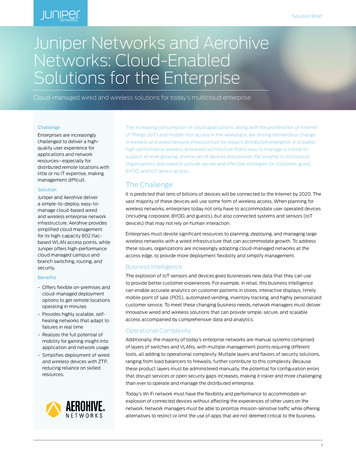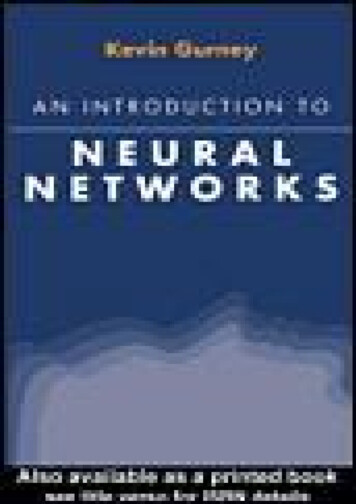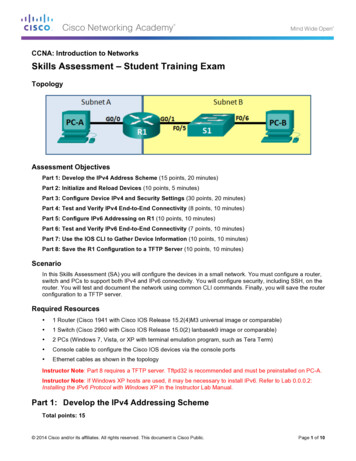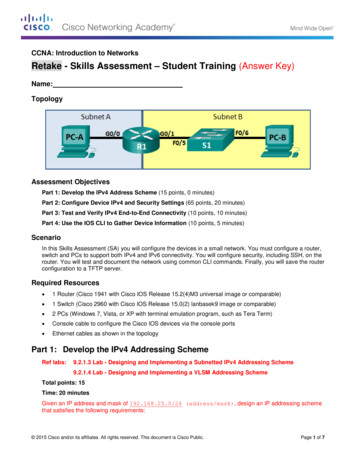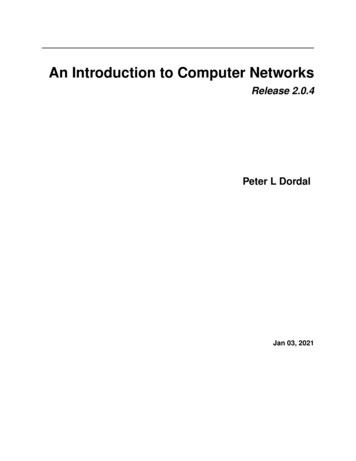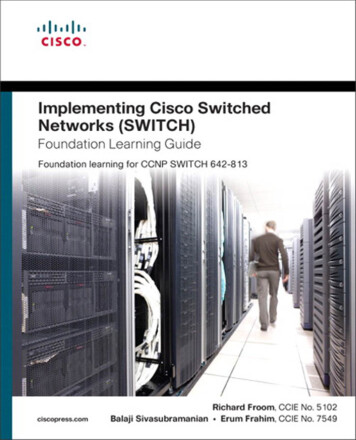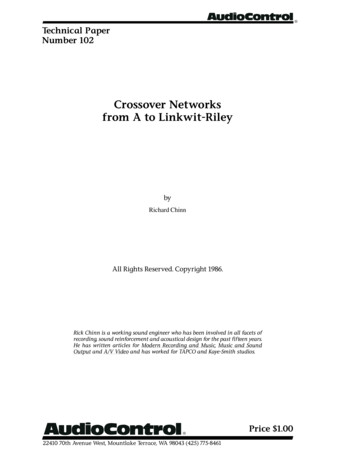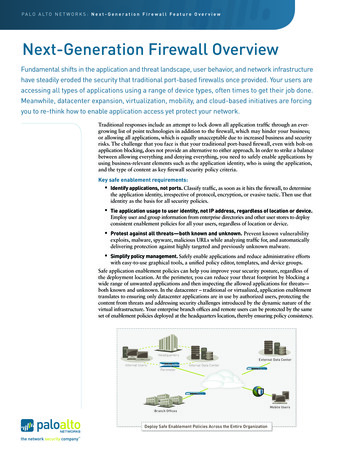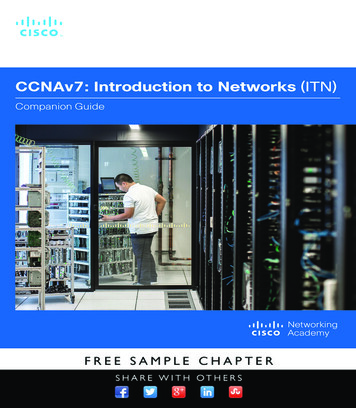
Transcription
Introduction to NetworksCompanion Guide (CCNAv7)Cisco Networking AcademyCisco Press
iiIntroduction to Networks Companion Guide (CCNAv7)Introduction to NetworksCompanion Guide (CCNAv7)Cisco Networking AcademyCopyright 2020 Cisco Systems, Inc.Published by:Cisco PressAll rights reserved. No part of this book may be reproduced or transmitted in any formor by any means, electronic or mechanical, including photocopying, recording, or byany information storage and retrieval system, without written permission from the publisher, except for the inclusion of brief quotations in a review.ScoutAutomatedPrintCodeLibrary of Congress Control Number: 2020935402ISBN-13: 978-0-13-663366-2ISBN-10: 0-13-663366-8Warning and DisclaimerThis book is designed to provide information about the Cisco Networking AcademyIntroduction to Networks (CCNAv7) course. Every effort has been made to make thisbook as complete and as accurate as possible, but no warranty or fitness is implied.The information is provided on an “as is” basis. The authors, Cisco Press, and CiscoSystems, Inc. shall have neither liability nor responsibility to any person or entity withrespect to any loss or damages arising from the information contained in this book orfrom the use of the discs or programs that may accompany it.The opinions expressed in this book belong to the author and are not necessarily thoseof Cisco Systems, Inc.Trademark AcknowledgmentsAll terms mentioned in this book that are known to be trademarks or service marks havebeen appropriately capitalized. Cisco Press or Cisco Systems, Inc., cannot attest to theaccuracy of this information. Use of a term in this book should not be regarded as affecting the validity of any trademark or service mark.Microsoft and/or its respective suppliers make no representations about the suitability ofthe information contained in the documents and related graphics published as part of theEditor-in-ChiefMark TaubAlliances Manager,Cisco PressArezou GolDirector, ITP ProductManagementBrett BartowSenior EditorJames ManlyManaging EditorSandra SchroederDevelopment EditorChristopher ClevelandSenior Project EditorTonya SimpsonCopy EditorKitty WilsonTechnical EditorBob VachonEditorial AssistantCindy TeetersCover DesignerChuti PrasertsithCompositioncodeMantraIndexerErika MillenProofreaderAbigail Manheim
iiiservices for any purpose. All such documents and related graphics are provided “as is” without warranty of any kind.Microsoft and/or its respective suppliers hereby disclaim all warranties and conditions with regard to this information,including all warranties and conditions of merchantability, whether express, implied or statutory, fitness for a particularpurpose, title and non-infringement. In no event shall Microsoft and/or its respective suppliers be liable for any special,indirect or consequential damages or any damages whatsoever resulting from loss of use, data or profits, whether in anaction of contract, negligence or other tortious action, arising out of or in connection with the use or performance ofinformation available from the services.The documents and related graphics contained herein could include technical inaccuracies or typographical errors.Changes are periodically added to the information herein. Microsoft and/or its respective suppliers may makeimprovements and/or changes in the product(s) and/or the program(s) described herein at any time. Partial screenshots may be viewed in full within the software version specified.Microsoft and Windows are registered trademarks of the Microsoft Corporation in the U.S.A. and other countries. Screenshots and icons reprinted with permission from the Microsoft Corporation. This book is not sponsoredor endorsed by or affiliated with the Microsoft Corporation.Americas HeadquartersCisco Systems, Inc.San Jose, CAAsia Pacific HeadquartersCisco Systems (USA) Pte. Ltd.SingaporeEurope HeadquartersCisco Systems International BV Amsterdam,The NetherlandsCisco has more than 200 offices worldwide. Addresses, phone numbers, and fax numbers are listed on the Cisco Website at www.cisco.com/go/offices.Cisco and the Cisco logo are trademarks or registered trademarks of Cisco and/or its affiliates in the U.S. and other countries. To view a list of Cisco trademarks,go to this URL: www.cisco.com/go/trademarks. Third party trademarks mentioned are the property of their respective owners. The use of the word partner doesnot imply a partnership relationship between Cisco and any other company. (1110R)
ivIntroduction to Networks Companion Guide (CCNAv7)About the Contributing AuthorsRick Graziani teaches computer science and computer networking courses atCabrillo College and University of California, Santa Cruz in Santa Cruz, California.Prior to teaching, Rick worked in the information technology field for Santa CruzOperation, Tandem Computers, and Lockheed Missiles and Space Corporation, andhe served in the U.S. Coast Guard. He holds an M.A. in computer science and systems theory from California State University, Monterey Bay. Rick also works as a curriculum developer for the Cisco Networking Academy Curriculum Engineering team.When Rick is not working, he is most likely surfing at one of his favorite Santa Cruzsurf breaks.Allan Johnson entered the academic world in 1999, after 10 years as a businessowner/operator, to dedicate his efforts to his passion for teaching. He holds both anM.B.A. and an M.Ed. in training and development. He taught CCNA courses at thehigh school level for seven years and has taught both CCNA and CCNP courses atDel Mar College in Corpus Christi, Texas. In 2003, Allan began to commit much ofhis time and energy to the CCNA Instructional Support Team, providing services toNetworking Academy instructors worldwide and creating training materials. He nowworks full time for Cisco Networking Academy as Curriculum Lead.
vContents at a GlanceIntroduction xxxChapter 1Networking Today1Chapter 2Basic Switch and End Device ConfigurationChapter 3Protocols and Models 85Chapter 4Physical Layer 137Chapter 5Number Systems 175Chapter 6Data Link Layer 203Chapter 7Ethernet SwitchingChapter 8Network Layer 267Chapter 9Address ResolutionChapter 10Basic Router Configuration 319Chapter 11IPv4 Addressing341Chapter 12IPv6 Addressing397Chapter 13ICMPChapter 14Transport Layer 461Chapter 15Application Layer 507Chapter 16Network Security FundamentalsChapter 17Build a Small Network 571Appendix AAnswers to “Check Your Understanding” Questions45233297443Key Terms GlossaryIndex 669645541631
viiContentsIntroduction xxxChapter 1Networking TodayObjectives11Key Terms 1Introduction (1.0)3Networks Affect Our Lives (1.1) 3Networks Connect Us (1.1.1) 3No Boundaries (1.1.3)3Network Components (1.2)4Host Roles (1.2.1) 4Peer-to-Peer (1.2.2) 5End Devices (1.2.3)6Intermediary Devices (1.2.4) 6Network Media (1.2.5)7Network Representations and Topologies (1.3) 8Network Representations (1.3.1) 8Topology Diagrams (1.3.2) 10Physical Topology Diagrams 10Logical Topology Diagrams 10Common Types of Networks (1.4)11Networks of Many Sizes (1.4.1) 11LANs and WANs (1.4.2) 12LANs 13WANs 14The Internet (1.4.3) 15Intranets and Extranets (1.4.4)Internet Connections (1.5)1617Internet Access Technologies (1.5.1)17Home and Small Office Internet Connections (1.5.2) 18Businesses Internet Connections (1.5.3) 19The Converging Network (1.5.4)20
viiiIntroduction to Networks Companion Guide (CCNAv7)Reliable Networks (1.6)23Network Architecture (1.6.1) 23Fault Tolerance (1.6.2) 24Scalability (1.6.3)24Quality of Service (1.6.4) 25Network Security (1.6.5) 26Network Trends (1.7)27Recent Trends (1.7.1) 28Bring Your Own Device (BYOD) (1.7.2) 28Online Collaboration (1.7.3) 28Video Communications (1.7.4)29Cloud Computing (1.7.6) 29Technology Trends in the Home (1.7.7) 31Powerline Networking (1.7.8)31Wireless Broadband (1.7.9) 32Wireless Internet Service Providers 32Wireless Broadband Service 32Network Security (1.8)33Security Threats (1.8.1)33Security Solutions (1.8.2) 34The IT Professional (1.9) 35CCNA (1.9.1) 35Networking Jobs (1.9.2)36Summary (1.10) 37Networks Affect Our Lives 37Network Components 37Network Representations and Topologies 37Common Types of NetworksInternet Connections3738Reliable Networks 38Network Trends 38Network SecurityThe IT Professional3940Practice 40Check Your Understanding Questions40
ixChapter 2Basic Switch and End Device Configuration45Objectives 45Key Terms45Introduction (2.0) 46Cisco IOS Access (2.1)46Operating Systems (2.1.1)GUI (2.1.2)4647Purpose of an OS (2.1.3)48Access Methods (2.1.4) 49Terminal Emulation Programs (2.1.5)IOS Navigation (2.2)5052Primary Command Modes (2.2.1)52Configuration Mode and Subconfiguration Modes (2.2.2)Navigate Between IOS Modes (2.2.4) 54A Note About Syntax Checker Activities (2.2.6)The Command Structure (2.3) 56Basic IOS Command Structure (2.3.1)56IOS Command Syntax Check (2.3.2) 57IOS Help Features (2.3.3) 58Hot Keys and Shortcuts (2.3.5) 58Basic Device Configuration (2.4)61Device Names (2.4.1) 61Password Guidelines (2.4.2)62Configure Passwords (2.4.3)6364Encrypt Passwords (2.4.4)Banner Messages (2.4.5)65Save Configurations (2.5) 66Configuration Files (2.5.1)67Alter the Running Configuration (2.5.2)68Capture Configuration to a Text File (2.5.4) 68Ports and Addresses (2.6) 71IP Addresses (2.6.1)71Interfaces and Ports (2.6.2)735553
xIntroduction to Networks Companion Guide (CCNAv7)Configure IP Addressing (2.7)74Manual IP Address Configuration for End Devices (2.7.1)75Automatic IP Address Configuration for End Devices (2.7.2) 76Switch Virtual Interface Configuration (2.7.4)Verify Connectivity (2.8)7778Summary (2.9) 79Cisco IOS Access 79IOS Navigation 7979The Command StructureBasic Device ConfigurationSave Configurations80Ports and Addresses80Configure IP AddressingVerify Connectivity798080Practice 81Check Your Understanding QuestionsChapter 381Protocols and Models 85Objectives 85Key Terms85Introduction (3.0) 86The Rules (3.1)86Communications Fundamentals (3.1.2)Communication Protocols (3.1.3)8687Rule Establishment (3.1.4) 88Network Protocol Requirements (3.1.5)Message Encoding (3.1.6)8889Message Formatting and Encapsulation (3.1.7)Message Size (3.1.8)91Message Timing (3.1.9)92Message Delivery Options (3.1.10) 92A Note About the Node Icon (3.1.11) 94Protocols 94Network Protocol Overview (3.2.1) 94Network Protocol Functions (3.2.2) 95Protocol Interaction (3.2.3)9690
xiProtocol Suites (3.3) 97Network Protocol Suites (3.3.1) 97Evolution of Protocol Suites (3.3.2) 98TCP/IP Protocol Example (3.3.3) 99TCP/IP Protocol Suite (3.3.4) 99Application Layer 101Transport Layer 102Internet Layer 102Network Access Layer 103TCP/IP Communication Process (3.3.5) 103Standards Organizations (3.4)Open Standards (3.4.1)108108Internet Standards (3.4.2) 108Electronic and Communications Standards (3.4.3) 111Reference Models (3.5) 111The Benefits of Using a Layered Model (3.5.1) 112The OSI Reference Model (3.5.2) 112The TCP/IP Protocol Model (3.5.3) 114OSI and TCP/IP Model Comparison (3.5.4)115Data Encapsulation (3.6) 116Segmenting Messages (3.6.1)116Sequencing (3.6.2) 118Protocol Data Units (3.6.3) 118Encapsulation Example (3.6.4)120De-encapsulation Example (3.6.5) 120Data Access (3.7)Addresses (3.7.1)121121Layer 3 Logical Address (3.7.2) 122Devices on the Same Network (3.7.3) 123Role of the Data Link Layer Addresses: SameIP Network (3.7.4) 124Devices on a Remote Network (3.7.5)125Role of the Network Layer Addresses (3.7.6)125Role of the Data Link Layer Addresses: DifferentIP Networks (3.7.7) 126Data Link Addresses (3.7.8)127
xiiIntroduction to Networks Companion Guide (CCNAv7)Summary (3.8) 130The Rules130Protocols130Protocol Suites 130Standards OrganizationsReference Models131131Data Encapsulation132Data Access 132Practice 133Check Your Understanding QuestionsChapter 4133Physical Layer 137Objectives 137Key Terms137Introduction (4.0) 138Purpose of the Physical Layer (4.1) 138The Physical Connection (4.1.1) 138The Physical Layer (4.1.2)139Physical Layer Characteristics (4.2)Physical Layer Standards (4.2.1)141141Physical Components (4.2.2) 142Encoding (4.2.3)142Signaling (4.2.4) 143Bandwidth (4.2.5) 145Bandwidth Terminology (4.2.6) 145Latency 146Throughput 146Goodput 146Copper Cabling (4.3) 146Characteristics of Copper Cabling (4.3.1) 147Types of Copper Cabling (4.3.2) 148Unshielded Twisted-Pair (UTP) (4.3.3)148Shielded Twisted-Pair (STP) (4.3.4) 150Coaxial Cable (4.3.5) 151
xiiiUTP Cabling (4.4)152Properties of UTP Cabling (4.4.1)152UTP Cabling Standards and Connectors (4.4.2)153Straight-Through and Crossover UTP Cables (4.4.3) 157Fiber-Optic Cabling (4.5)158Properties of Fiber-Optic Cabling (4.5.1) 158Types of Fiber Media (4.5.2) 159Single-Mode Fiber 159Multimode Fiber 160Fiber-Optic Cabling Usage (4.5.3) 160Fiber-Optic Connectors (4.5.4)Fiber Patch Cords (4.5.5)161162Fiber Versus Copper (4.5.6)163Wireless Media (4.6) 164Properties of Wireless Media (4.6.1)Types of Wireless Media (4.6.2)164165Wireless LAN (4.6.3) 166Summary (4.7) 168Purpose of the Physical Layer 168Physical Layer Characteristics 168Copper CablingUTP Cabling168169Fiber-Optic Cabling169Wireless Media 169Practice 170Check Your Understanding QuestionsChapter 5170Number Systems 175Objectives 175Key Terms175Introduction (5.0) 176Binary Number System (5.1)176Binary and IPv4 Addresses (5.1.1) 176Binary Positional Notation (5.1.3) 178
xivIntroduction to Networks Companion Guide (CCNAv7)Convert Binary to Decimal (5.1.5)180Decimal to Binary Conversion (5.1.7) 182Decimal to Binary Conversion Example (5.1.8) 186IPv4 Addresses (5.1.11) 193Hexadecimal Number System (5.2)194Hexadecimal and IPv6 Addresses (5.2.1)194Decimal to Hexadecimal Conversions (5.2.3) 196Hexadecimal to Decimal Conversion (5.2.4) 196Summary (5.3) 198Binary Number System198Hexadecimal Number System 198Practice 198Check Your Understanding QuestionsChapter 6198Data Link Layer 203Objectives 203Key Terms203Introduction (6.0) 204Purpose of the Data Link Layer
Network Media (1.2.5) 7 Network Representations and Topologies (1.3) 8 Network Representations (1.3.1) 8 Topology Diagrams (1.3.2) 10 Physical Topology Diagrams 10 Logical Topology Diagrams 10 Common Types of Networks (1.4) 11 Networks of Many Sizes (1.4.1) 11 LANs and WANs (1.4.2) 12 LANs 13 WANs 14 The Internet (1.4.3) 15 Intranets and Extranets (1.4.4) 16 Internet
